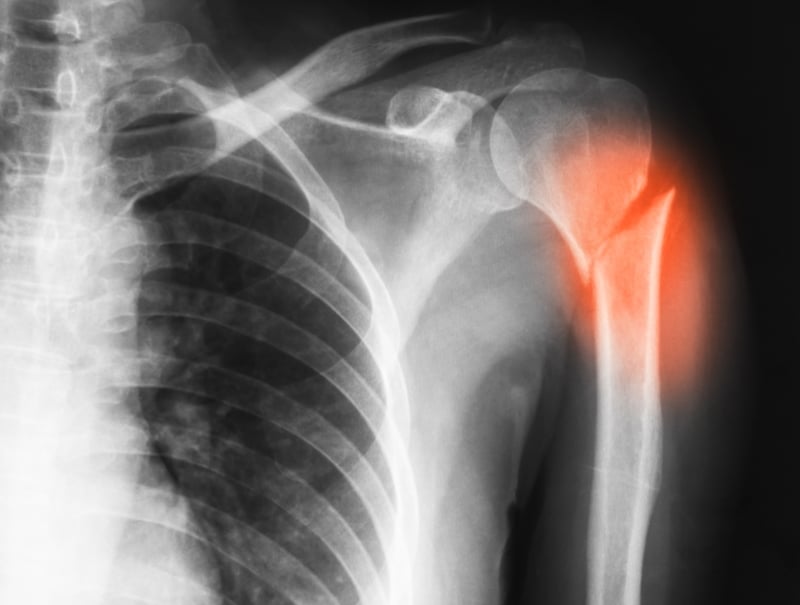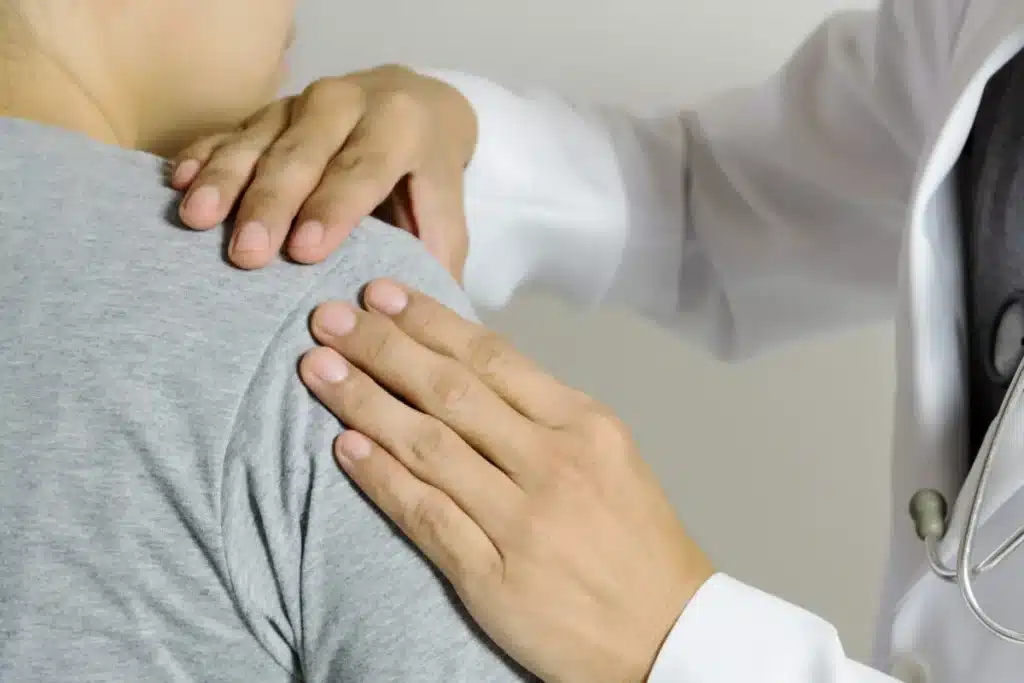This website uses cookies so that we can provide you with the best user experience possible. Cookie information is stored in your browser and performs functions such as recognising you when you return to our website and helping our team to understand which sections of the website you find most interesting and useful.

A proximal humerus fracture occurs close to the shoulder and can be located at different levels with different fracture patterns: simple or comminuted. (Broken Shoulder)
A humerus shaft fracture is a break occurring at the mid portion of the upper arm. (Broken Upper Arm)

A proximal humerus fracture is a type of fracture that occurs in the upper part of the arm bone (humerus), near the shoulder joint. It’s one of the most common fractures involving the shoulder, and it can vary widely in severity, ranging from a small crack to a complete break that may involve displacement of bone fragments.
Causes: Proximal humerus fractures typically result from trauma, such as falls onto an outstretched arm, direct blows to the shoulder, or high-energy impacts like those seen in car accidents. In older adults, these fractures are often associated with osteoporosis, a condition characterized by weakened bones.
A humerus shaft fracture refers to a break or fracture in the middle portion of the humerus bone, the long bone in the upper arm. This type of fracture can vary in severity, from simple fractures with minimal displacement to more complex fractures with significant displacement or fragmentation of the bone.
Causes: Humerus shaft fractures can result from various traumatic events, including falls onto an outstretched arm, direct blows to the arm, or high-energy impacts such as those seen in car accidents or sports injuries. They can also occur due to repetitive stress or overuse, particularly in athletes engaged in activities that involve throwing or repetitive arm motions.
It’s important for patients with a humerus shaft fracture to contact our medical team immediately and follow all recommendations closely to ensure proper healing and minimize the risk of complications.
If you are experiencing pain in your shoulders and need medical care, please contact Dr. Stephen W. Pournaras and our professional medical staff can help you recover by simply contacting us today.
Symptoms of a proximal humerus fracture, which occurs in the upper part of the arm bone near the shoulder joint, can vary depending on the severity of the fracture.
Pain: is usually the most noticeable symptom of a proximal humerus fracture. The pain may be severe and sharp, particularly with movement of the shoulder or arm.
Swelling: around the shoulder area is common following a proximal humerus fracture. The affected area may appear swollen and feel tender to the touch.
Bruising: or discoloration of the skin around the shoulder may occur due to bleeding beneath the skin as a result of the fracture.
Difficulty Moving the Shoulder: The shoulder’s ability may be limited or restricted due to pain and swelling. Movements such as lifting the arm or reaching overhead may be particularly challenging.
Visible Deformity: In severe cases of proximal humerus fracture, there may be a visible deformity or abnormal shape of the shoulder joint. This can occur if the bone fragments are displaced or if there is significant damage to the surrounding tissues.
Tenderness: The area around the shoulder may be tender to the touch. Palpating or pressing on the shoulder may elicit pain.
Numbness or Tingling: If nerves in the shoulder area are affected by the fracture, numbness or tingling sensations may occur in the arm or hand. This can occur if the fracture causes compression or damage to nearby nerves.
Weakness: Weakness in the shoulder and arm muscles may occur due to pain and immobility. This weakness can affect the ability to perform everyday activities that require arm use.
Treatment for a proximal humerus fracture, which occurs in the upper part of the arm bone near the shoulder joint, depends on several factors, including the severity of the fracture, degree of displacement, patient’s age and overall health, and presence of associated injuries.
Immobilization: Nondisplaced or minimally displaced fractures may be treated conservatively with immobilization in a sling, splint, or brace to support the arm and shoulder during healing.
Pain Management: Over-the-counter or prescription pain medications may be recommended to manage pain and discomfort associated with the fracture.
Physical Therapy: Once the acute pain and swelling subside, physical therapy may be initiated to restore range of motion, strength, and function to the shoulder joint. Physical therapists can provide exercises and modalities to help with recovery.
Open Reduction and Internal Fixation (ORIF): Severe fractures with significant displacement, multiple fragments, or involvement of the joint surface may require surgery. During an ORIF procedure, the bone fragments are repositioned (reduced) into their normal alignment and held together with plates, screws, or pins to stabilize the fracture.
Hemiarthroplasty or Total Shoulder Replacement: In cases of severe fracture involving damage to the shoulder joint, particularly in older adults with poor bone quality, a shoulder replacement surgery may be performed. This involves replacing the damaged parts of the shoulder joint with prosthetic components to restore function and reduce pain.
Rehabilitation: Regardless of the treatment approach, rehabilitation is a crucial component of recovery from a proximal humerus fracture. Physical therapy helps to improve shoulder mobility, strength, and function, reducing the risk of stiffness and complications.
Exercises may focus on range of motion, strengthening of the shoulder and arm muscles, and functional activities to help regain independence in daily tasks.
Follow-Up Care:
Regular follow-up appointments with our medical team are essential to monitoring healing progress and adjusting the treatment plan as needed.
X-rays or other imaging studies may be repeated to evaluate bone healing and alignment.
Activity Modification:
During the recovery period, it is important to avoid activities that may put excessive stress on the healing bone, such as heavy lifting or overhead movements.
Our physical therapists should guide gradual return to activities and sports to prevent re-injury.
Make Your Appointment Today
Fair Oaks Ortho – Fairfax,VA


